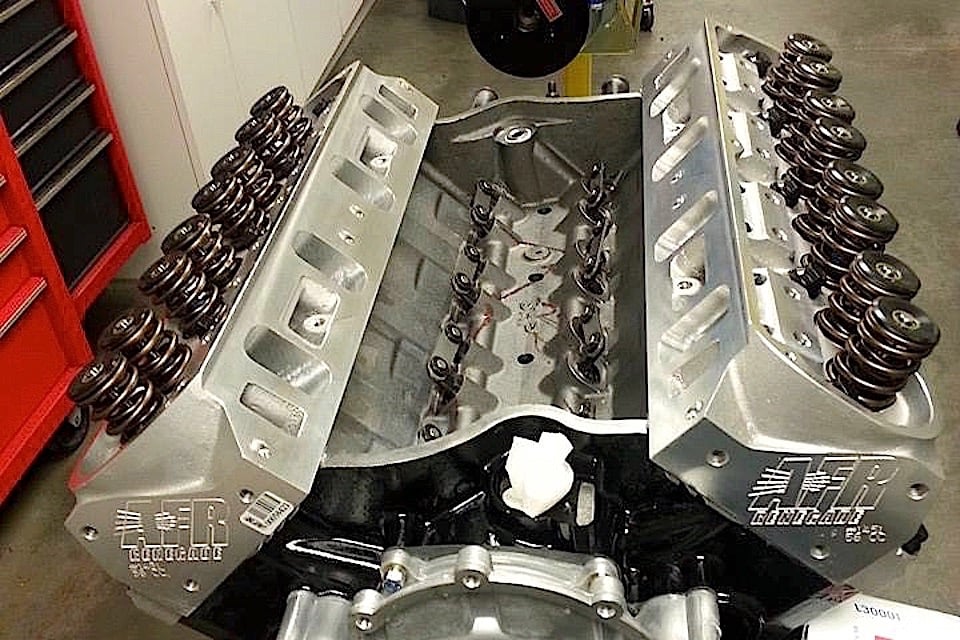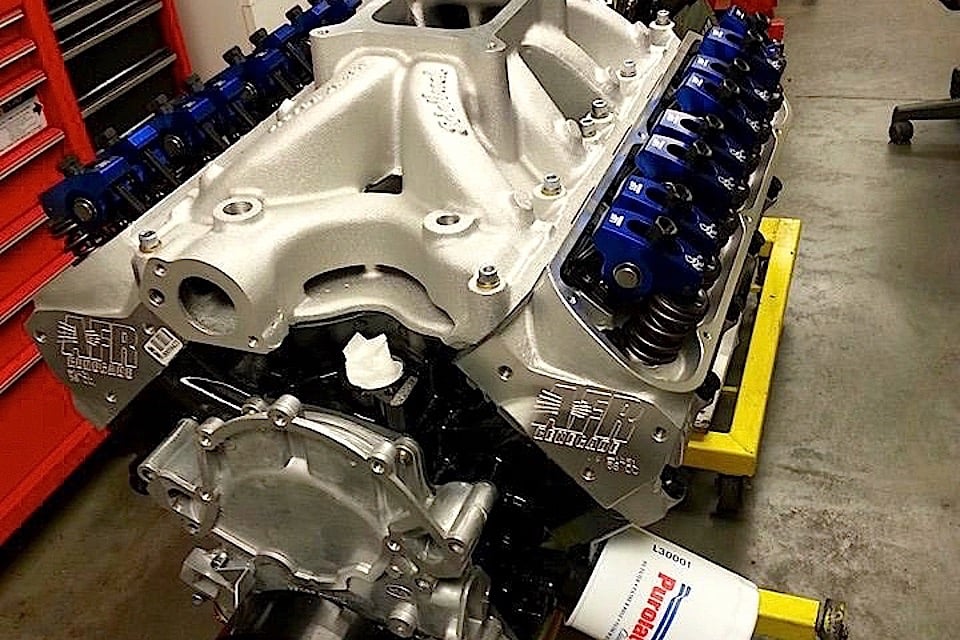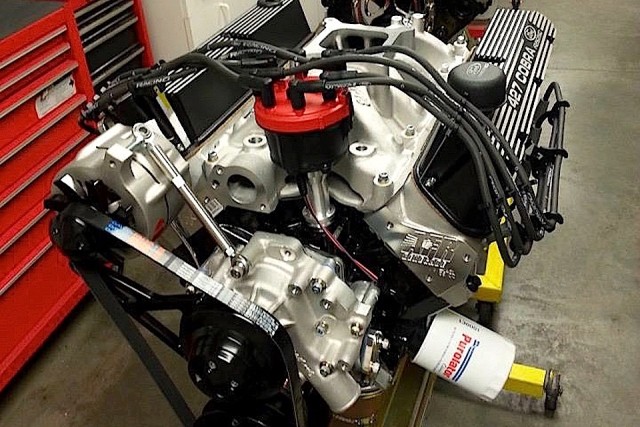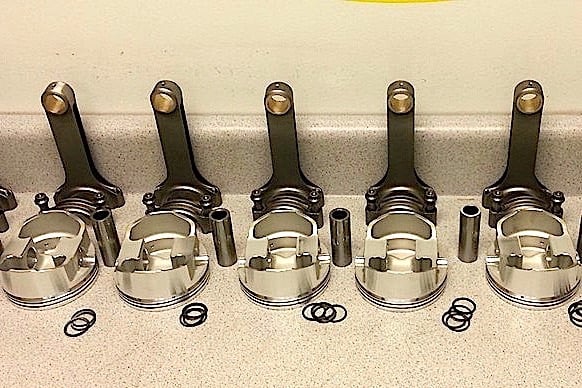Two elements of the story behind this 427ci Ford Windsor engine from Prestige Motorsports [1] quickly drew our attention to the above video.
First, the engine was baselined with a carburetor before a Holley [2] Terminator self-learning EFI system was swapped in place. Conducting an A-B comparison of carbs and fuel injection on the dyno always adds flavor to the debate between these two induction choices, especially for engines built to run on the street.
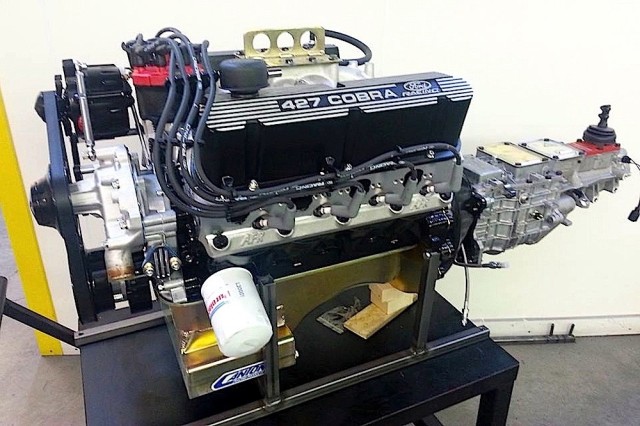 [3]
[3]Here’s the Prestige Motorsports 427 with a mockup of the transmission before it’s shipped to be installed in a Cobra replica.
Second, this small-block Ford is very similar in parts selection to an EngineLabs [4] project titled 428 Pony Jet [5]. The Prestige motor pumped out about 50 more horsepower. Let’s find out why.
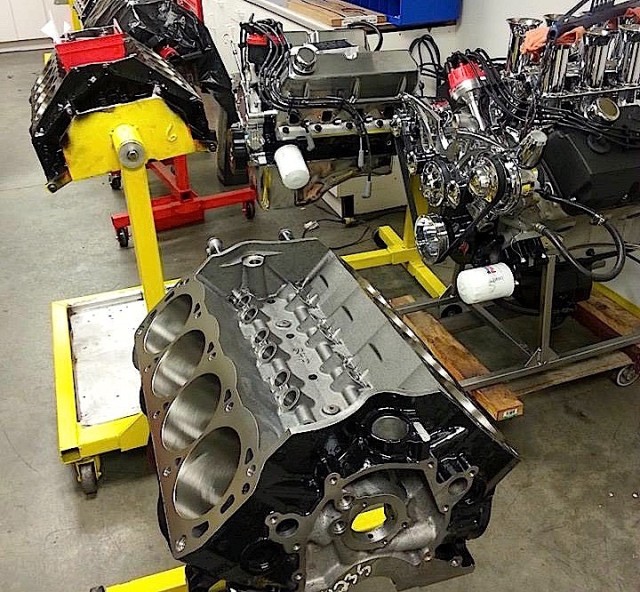 [6]
[6]Here’s the Dart SHP block before assembly. Note the Hilborn-injected Hemi off the side. You may see more of that bullet on EngineLabs soon.
The foundations for both engines include a Dart [7] SHP block fitted with an Eagle [8] 4340 forged-steel crankshaft and H-beam connecting rods tightened with ARP [9] 2000 bolts. Prestige went with custom JE [10] pistons (10.5:1 compression) while Pony Jet used off-the-shelf Mahle [11] (10.7:1).
“We’ve been working with a new piston and ring package since we first baselined this combination,” says Doug Aitken, president at Prestige Motorsports. “We’re always striving for a little more.
Bore and stroke is 4.125-inch x 4.000-inch, resulting in 427.6ci total displacement. Prestige rounded down, we rounded up. Each engine used a Melling [12] oil pump with Prestige choosing a 7-quart Canton [13] pan and EngineLabs going with a 9-quart Moroso [14].
Getting down to details
The big differences in the two engines, of course, are the camshaft and cylinder heads. Prestige chose a custom Comp Cams [15] solid-roller grind (254/260 duration at .050-inch lift; .622-inch/.628-inch intake and exhaust lift figures; 108 LSA) while Pony Jet relies on a custom Crane [16] hydraulic roller (244/252 at .050-inch lift; .640-inch lift on both intake and exhaust; 110 LSA). The Prestige cam with BAM Products [17] solid roller lifters is noticeably more aggressive with longer duration and tighter lobe-separation angle to encourage more top-end power.
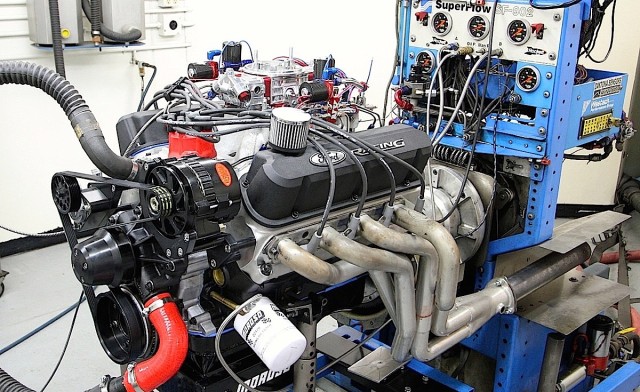 [18]
[18]Here’s the EngineLabs 428 Pony Jet project that was similar in many ways to the Prestige engine but didn’t have quite as an aggressive cam and cylinder head package.
Prestige also went with bigger cylinder heads, selecting AFR [19]’s Renegade 220 model with full CNC ports that lead to 2.100-inch/1.570-inch valves. Pony Jet had Edelbrock [20] Victor Jr. heads with limited CNC porting and 2.050-inch/1.600-inch valves. The larger AFR heads featured race-inspired 220cc intake ports while the Edelbrock was more street oriented with 210cc intake ports. Both heads sported 1.6:1 rocker arms, Scorpion [21] on the Prestige while Crane was found on the EngineLabs motor.
Both engines used Edelbrock intakes with Prestige selecting a Victor Jr. while Pony Jet had a Super Victor that had been plumbed with a Nitrous Express [22] direct-port system. The Pony Jet engine relied on a Quick Fuel [23] 850cfm carburetor while the Prestige engine finished its dyno session with a Holley Terminator EFI.
Here's a closer look at the AFR Renegade 220 cylinder heads and the Edelbrock Victor Jr. intake manifold on the Prestige engine.
Comparing torque and horsepower
So, how did the dyno numbers differ?
Project Pony Jet peaked out at 524 lb-ft torque at 4,400 rpm while the Prestige engine hit 541 lb-ft at 5,000 rpm. Pony Jet maxed out at 523 horsepower at 5,900 rpm while the Prestige engine hit 575 horsepower at 6,500 rpm.
Airflow was certainly the key to enhancing the top-end performance. Bigger cylinder heads combined with a more aggressive cam timing shifted the power curve upwards. The Pony Jet engine certainly offered plenty of torque and at a significantly lower rpm range, so it would probably offer a little better off-idle and passing-gear throttle response. BTW, the Pony Jet hit 750 horsepower when a 200-horse shot of nitrous was applied. Just saying!
Regarding the back-to-back, carb vs. EFI tests, the differences were hardly noticeable.
“It’s was so close,” says Aitken. “They’re only a couple pound-feet off. At 4,600 rpm, the carb was 538 while the Holley system was 536. We made peak at 5,000 with 541. Again, only a couple pound-feet off. It was close, and the fuel curves were darn near the same.”
Aitken is a fan of the Holley system with its tuning flexibility.
“The Terminator is self-learning but you can also hook a laptop to it and fine tune the engine,” says Aitken. “Take a motor with little vacuum at idle and it’s having trouble learning. It ends up digging itself into a hole in the fuel map. With a laptop we can turn the learning off, fine tune the idle circuit, then turn the learn phase back on at 1500 or 1800 rpm once you roll into the throttle.”
Aitken also says he doesn’t let the ECU manage ignition timing, as that’s a function that customers often choose to adjust the traditional way.
“A lot of guys don’t trust themselves getting into the computer to play with timing,” adds Aitken. “We tend to keep it on a standard mechanical advance curve. We use a lighter weight spring on the MSD Pro Billet and shorten up the curve to 16 to 18 degrees at idle and 32 full to keep it safe.”
